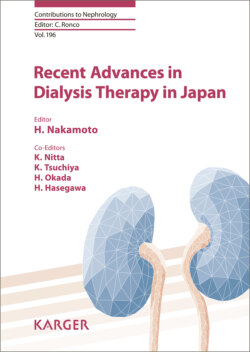Читать книгу Recent Advances in Dialysis Therapy in Japan - Группа авторов - Страница 69
На сайте Литреса книга снята с продажи.
Relationship between CKD and Dementia
ОглавлениеThe relationship between CKD and dementia was investigated in the Hisayama Study. Takae et al. [16] investigated the association between CKD and the development of dementia based on the results of a follow-up study in the residents of the town of Hisayama in Fukuoka Prefecture, Japan. Of all the residents ≥60 years of age who underwent the health screening program for elderly residents of the town in 2002 and 2003, 1,562 residents without dementia were followed-up for 10 years and the associations of the urinary albumin/creatinine ratio (UACR) and eGFR with the development of dementia was examined using a Cox proportional hazards model. After adjustment for multivariable confounders, the incidence of all-cause dementia rose significantly with increasing quartiles (Qs) of UACR, with the hazard ratios for dementia (after multivariable adjustment) being significantly higher in the Q3 and Q4 groups as compared to the Q1 group. When the outcome was divided by the type of dementia; that is, Alzheimer disease and vascular dementia, the risk for both types of dementia rose significantly with increasing UACR. In terms of the relationship between kidney function and dementia, a significant increase in the risks of all-cause and vascular dementia was observed in patients with an eGFR of <60 mL/min/1.73 m2, while no such association was observed for Alzheimer dementia.
Fig. 6. Effect of tempol on prevention of uremia-induced spatial working memory dysfunction and inhibition of 8-hydroxydeoxyguanosine (8-OHdG) accumulation in the hippocampal cornu ammonis 3 (CA3) region. a The numbers of errors during the radial arm water maze test on the fifth day in control-vehicle (Cont-Veh), chronic kidney disease-vehicle (CKD-Veh), control-tempol (Cont-TMP), and chronic kidney disease-tempol (CKD-TMP) mice are shown. The number of errors in CKD-TMP mice is significantly decreased to levels similar to those observed in control mice, and significantly lower than in CKD-Veh mice. The whiskers represent maximum and minimum values. * p < 0.05 vs. the other three groups. b Effect of TMP on prevention of oxidative DNA damage generation. Representative microphotographs of 8-OHdG immunostaining in the hippocampal CA3 region from each group are shown. Magnification: ×200. Quantitative analysis of 8-OHdG-positive neurons in the hippocampal CA3 region is shown. 8-OHdG immunoreactivity in the hippocampal CA3 region is significantly higher in CKD-Veh mice than TMP-treated CKD mice. The ends of the box represent the upper and lower quartiles; thus, the box spans the interquartile range. The median is marked by a horizontal line inside the box. The whiskers represent the highest and lowest observations. * p < 0.05 vs. Cont-Veh mice. †p < 0.05 vs. CKD-Veh mice. Reproduced from [17].
